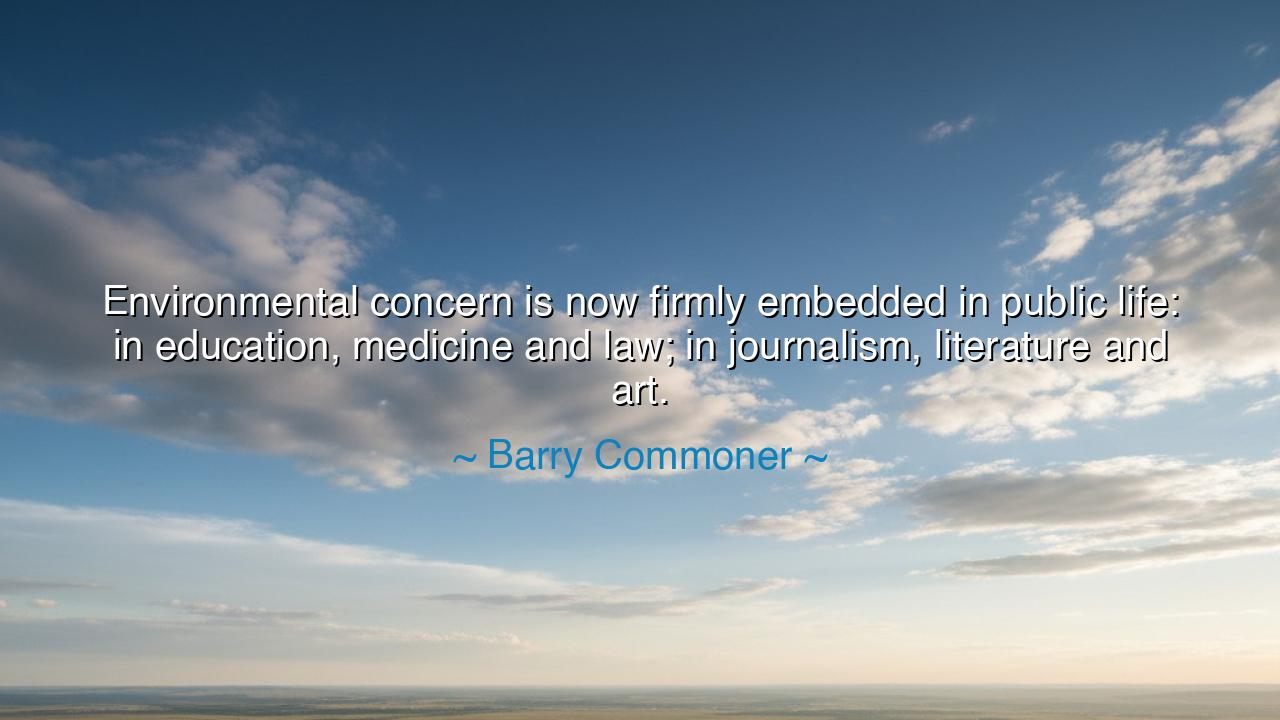
Environmental concern is now firmly embedded in public life: in
Environmental concern is now firmly embedded in public life: in education, medicine and law; in journalism, literature and art.






Hear the old bell ring in a new century: “Environmental concern is now firmly embedded in public life: in education, medicine and law; in journalism, literature and art.” With this pronouncement, Barry Commoner—biologist, teacher, and herald of the modern green awakening—names a transformation both quiet and immense. He tells us that care for the earth has moved from the margins to the marrow, from a protest at the gates to a principle at the altar. What was once a warning has become a woven thread, dyed into the garments of our common living.
Consider what it means to be “embedded.” A seed embedded in soil is not an ornament but a beginning. So too environmental concern in education: the child who learns the water cycle alongside arithmetic will one day count not only coins but rivers. In medicine, doctors now read the lungs with the same attention they give the air outside the clinic; toxins and tumorous growths are discussed alongside traffic and tailpipes. In law, constitutions and courtrooms wrestle with the rights of rivers and the meaning of a climate promise. This is no passing fashion; it is the slow engraving of value into habit, and of habit into policy.
The arts and letters bear witness as well. In journalism, the front page that once reserved a corner for “weather” now carries the long weather of centuries; reporters follow storms across spreadsheets and villages alike. In literature, the novel learns to listen for the speech of forests and fisheries; in art, canvases bloom with coral and ash, with mourning and resolve. To say that environmental concern lives in literature and art is to say that it has entered the chamber of memory and myth, where a people stores its deepest vows.
Let history offer a lantern. In 1969 the Cuyahoga River burned, and a city watched flames lick the surface of water. The shock coursed through classrooms, clinics, courtrooms, and newsrooms. Students organized teach-ins; physicians linked asthma to the air that fed the fire; lawmakers forged the Clean Air Act and Clean Water Act; editors put the blaze on the page; poets turned it into a parable. One year later, the first Earth Day gathered millions, not as a sect but as a nation learning a new prayer. Thus a single wound became a curriculum, a policy, a headline, and a hymn—environmental concern embedded in public life.
This is the heart of Commoner’s wisdom: when a value crosses the boundary of a single discipline, it becomes a civic rhythm. When the school, the hospital, the courthouse, and the studio all kneel to the same north star, culture itself changes its stride. The law can set a standard; medicine can count the cost; education can sow the vision; journalism can keep the ledger; literature can teach the heart to feel; art can make the invisible visible. Alone, each is a string; together, they are a lyre that can summon a different future.
Do not mistake this embeddedness for completion. A statute can be signed and still be ignored; a syllabus can be printed and still be lifeless; a museum can mount a show and still miss the storm outside its doors. The engraving must be renewed each day—carved deeper by practice, defended against convenience, brightened by imagination. The work is not to admire the embedding, but to make it bear fruit: cleaner air in the lungs of the poor, cooler classrooms under hotter suns, rivers that carry fish and not fire.
Therefore, let a simple rule be carried forward like a staff: when you take up your craft, take up the earth with it. Teachers, thread environmental concern through your education—let every subject touch soil, water, energy, and justice. Healers, count the neighborhood among your patients and treat medicine as stewardship of bodies and places. Advocates, weld the claims of future children into law that lasts longer than a term of office. Reporters, keep the long story in your journalism—follow causes, not only crises. Writers and painters, let literature and art hold grief without surrender and hope without denial. And for each of us: measure your footprint, choose the durable over the disposable, honor repair, vote with ballots and with purchases, plant where you can, and mentor one more soul into courage. In these ways the engraving deepens, and Commoner’s sentence becomes not just true, but triumphant.






AAdministratorAdministrator
Welcome, honored guests. Please leave a comment, we will respond soon